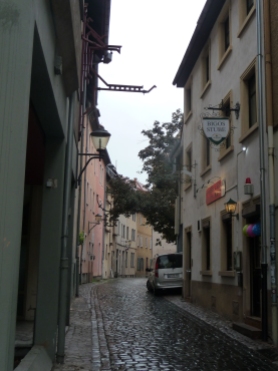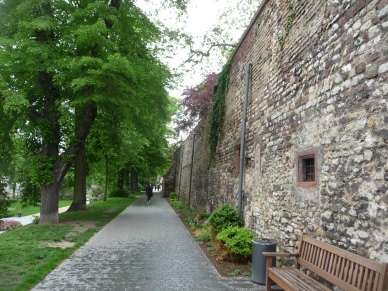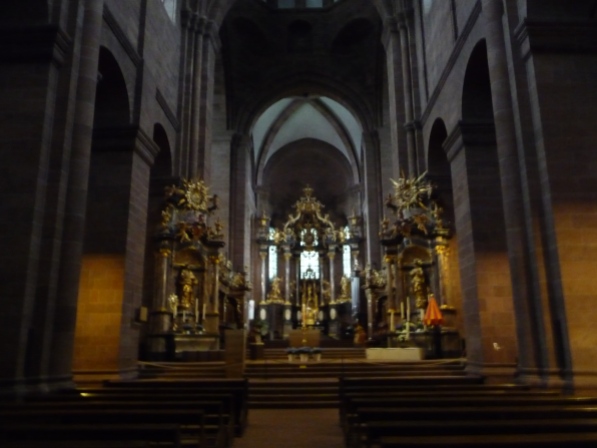Worms (the German town on the Rhine) used to induce sniggers in history lessons at school when discussing the significance of the Diet of Worms. Nothing to do with some continental delicacy “a la escargots” (snails), it was in fact an important assembly (Diet) of powerful nobles, churchmen and advisors called by the Holy Roman Emperor, Charles V, in 1521 to address the issue of Martin Luther and the Protestant Reformation. Luther had set off a revolutionary wave that swept Europe when he nailed his “95 Theses” to the door of the Wittenberg Castle Church four years earlier in 1517.
Worms is in fact pronounced “Vorms” in Germany with an “or” sound rather than “er” as in English. The German word for “worms” is der Wurm or plural “die Wuermer”.
It was only a 40 minute train ride from our base in Mainz down to Worms and so we set off on yet another rather grey and rainy day to explore more (we didn’t have much luck with the weather on our trip this May). Intrinsically involved in the struggles between Catholicism and the Protestant Reformation in the 1500s and beyond, Worms was also a leading centre for medieval Ashkenazic Judaism. This community existed for hundreds of years before being swept away when the horrors of Kristallnacht in 1938 unleashed a terrible tide of destruction. We wondered what the city would be like today and how much of the past has been restored or preserved.
Our first impressions were that Worms seemed like a typical clean and pristine German town. Quieter that we expected and not obviously touristy but it was a rather dreary day and perhaps that had put visitors off.
We made our way towards the Old Town and wandered round the narrow streets. The building on the corner (in the photo below) houses a casual self-service restaurant that offers a wonderful array of local produce and home-cooked food at very reasonable prices. Soups, hearty meat stews, a wide variety of vegetables plus a couple of glasses of the local vino set us up well for an afternoon exploring in between the rain showers.

We explored the old Jewish Quarter in a couple of stages having started off before lunch. The Judengasse (Jewish Alley) leads off the junction in the photo above. This was the quarter of the city where for many centuries the Jews were required to live. The Hebrew word for Worms was “Warmaisa” (see here for more information). Much of its significance derived from its association with Rabbi Salomon ben Isaak known as Rashi who studied at the Yeshiva (Jewish School) in Worms around 1060 and wrote an important commentary on the Talmud.
In the 1970s and 80s the old Jewish Synagogue was restored and a museum set up in the Rashi House. It was a very moving and poignant place to visit – we looked round the Jewish Museum at some length and also went into the Synagogue but the Mikvah (Jewish Ritual Bath) under the adjacent grounds was closed for restoration work.
With a break in the rain we headed off to find the Cathedral and also walk along the route of the old town walls towards the Jewish Cemetery. En route we passed through the main town square again and also found ourselves in some attractive gardens. In the centre was a large statue commemorating Luther’s links to the city with various other significant figures to do with the Reformation.
Luther was lucky to escape with his life.
The upshot of the Diet of Worms was the Edict of Worms, issued on 25 May 1521 by Emperor Charles V. It declared:
For this reason we forbid anyone from this time forward to dare, either by words or by deeds, to receive, defend, sustain, or favour the said Martin Luther. On the contrary, we want him to be apprehended and punished as a notorious heretic, as he deserves, to be brought personally before us, or to be securely guarded until those who have captured him inform us, whereupon we will order the appropriate manner of proceeding against the said Luther. Those who will help in his capture will be rewarded generously for their good work.
Luther had in fact been “guaranteed” safe passage to and from the Diet under the protection of a powerful supporter Prince Frederick III, Elector of Saxony. Not surprisingly the machinations going on behind the scenes were designed to trick him and have him arrested and tried for heresy. Frederick, aware of this, arranged for a fake highway robbery to take place whilst Luther was leaving Worms to return home. He was whisked away to the safety of the Wartburg Castle where he spent years in seclusion and translated the New Testament into German.
Illustrating Worms’s rich history we then visited the nearby Romanesque Cathedral (Dom St Peter). Similar to the one in Mainz it was an imposing structure – one can imagine the sense of power and prestige it conveyed in the Middle Ages when the powerful Prince Bishops controlled these cities.
Nearby we had another moving experience, walking through the old Jewish Cemetery known as “Holy Sands” or “Heiliger Sand” in German. The oldest grave dates back to 1058/9 and it was in use as a Jewish burial ground for centuries. I read in a local guidebook that for some unknown reason it wasn’t destroyed by the Nazis although any remaining Jews in Worms were deported during the war. It seems something of a mystery as to why it was left untouched. Today it belongs to the Jewish Congregation of Mainz as there is no longer a formal congregation in Worms. The City of Worms maintains the graveyard. Although entry is free, donations deposited in the box on the wall are much appreciated. Many of the graves are very old including those of important and distinguished rabbis. Pilgrims leave gifts and notes asking for prayers to be answered on the grave stones. The more recent ones, which I could understand, were in German. It covers a large area and it is incredible to think it has stood here for so long.
Worms is one of the three ShUM cities on the Rhine (the others are Speyer and Mainz) which have great significance in European Jewish history. An application is currently under consideration for them to be granted UNESCO World Heritage Status.
Finally after a long day exploring we ended up in a quaint cafe, the Affenhaus, in the Judengasse enjoying some afternoon tea (and some early aperitifs!) before heading back to the station to catch the train back up to Mainz. Worms turned out to be a fascinating place to visit, rich in history, beautifully maintained and easy to explore on foot (in spite of the rain)!
This wraps up my series of posts about our trip to Germany in May. You can read the others here.
I’ll be focusing on posts nearer home in Western Australia over the festive season then continuing with London (our trip to see our daughter Mlle) plus finishing my well overdue account of our Alaskan travels last year!
Copyright © 2019 Rosemary Thomas Le Chic En Rose. All rights reserved


























































I’d never heard of the place, Rosemay. Shame on me! 😦 I like the look of the Romanesque Cathedral though, and Jewish museums are always interesting. And I bet there was good cake 🙂 🙂 Take care, hon!
LikeLiked by 1 person
It’s probably not well known Jo – I just happened to study it in history and of course the name stuck in my head! The Cathedral was very impressive – on a hill, a high point in the city though undergoing renovations! The Jewish Museum was fascinating and so glad they are preserving this special place for visitors both Jewish and non Jewish. And yes the cake was good! Such a quaint cafe and a lovely way to finish off our day in Worms. Will be along for a Monday Walk later today X 😃😃
LikeLiked by 1 person
The title of your blog post got my attention and made me giggle. Certainly a lot of history in “Worms “, I have never heard of this place before. Thank you for another lovely post on this area of Germany, it has definitely picked my interest.
LikeLiked by 1 person
You’re very welcome Gilda – I didn’t know whether anyone would be interested in Worms! It’s a niche place – if you love history it’s absolutely fascinating. So accessible to nearby places such as Frankfurt, Mainz and the Mittel Rhein area. Highly recommend this part of Germany – also there is wine in abundance and delicious food and lots of fresh grown vegetables -certainly not all beer and “Wuerst”! 😃
LikeLike
Interesting place. I can hardly believe it’s May though to see you all bundled up with hats and scarves! You really weren’t lucky with the weather.
LikeLiked by 1 person
It was a fascinating place Anabel in spite of the weather. When we were staying in Koblenz in 2011 we had very hot weather in April and I had to go and buy some summer clothes! The weather can be unpredictable especially in spring!
LikeLiked by 1 person
Interesting and beautiful photos!
LikeLike